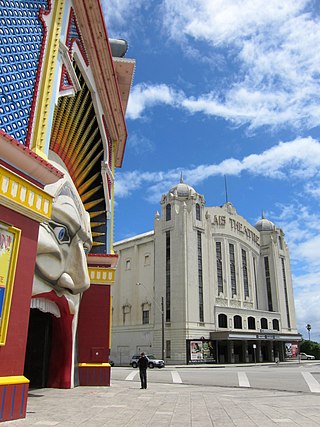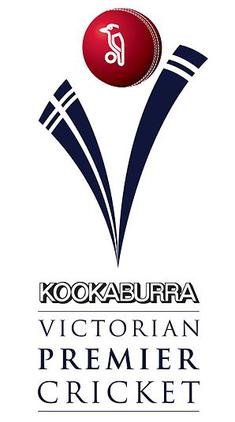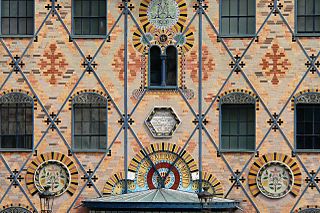Gallery
- Prahran Town Hall
- College for the Blind
- College for the Deaf
- Chinese Mission Church
- Durham Street Methodist Church
- Colombo Street Methodist Church
- East Melbourne Synagogue
- Union Bank, Brisbane
Crouch and Wilson was an architectural practice based in Melbourne, Australia in the late nineteenth century. The partnership, between Tasmanian-born Thomas Crouch and recently arrived Londoner Ralph Wilson, commenced in 1857 in Elizabeth Street. [1] The firm designed numerous prominent Melbourne buildings including many Presbyterian and Wesleyan churches. [2] After the deaths of the partners in the late 1880s, their sons continued on with the business until its closure in 1916. [1]

St Kilda is an inner seaside suburb in Melbourne, Victoria, Australia, six kilometres southeast of the Melbourne central business district, located within the City of Port Phillip local government area. St Kilda recorded a population of 19,490 at the 2021 census.

South Yarra is an inner-city suburb in Melbourne, Victoria, Australia, 4 km south-east of Melbourne's Central Business District, located within the Cities of Melbourne and Stonnington local government areas. South Yarra recorded a population of 25,028 at the 2021 census.

Toorak is a suburb of Melbourne, Victoria, Australia, 5 km (3.1 mi) south-east of Melbourne's Central Business District, located within the City of Stonnington local government area. Toorak recorded a population of 12,817 at the 2021 census.

St Kilda Road is a street in Melbourne, Victoria, Australia. It is part of the locality of Melbourne which has the postcode of 3004, and along with Swanston Street forms a major spine of the city.

Chapel Street is a street in Melbourne, Victoria, running along the inner suburbs of South Yarra, Prahran, Windsor, St Kilda and St Kilda East.

The Melbourne cable tramway system was a cable car public transport system, which operated between 1885 and 1940 in Melbourne, Victoria, Australia.

The Victorian College for the Deaf (VCD), located on St Kilda Road in Melbourne, Australia, is Victoria's oldest deaf school, opening in 1860. The Victorian College for the Deaf is Australia's only Prep to Year 12 Specialist in Deaf Education. Education is provided using a bilingual philosophy of teaching through Auslan, the language of the Australian deaf community, and English as the second language. It has a significant role in the history of Australian deaf culture.

Victorian Premier Cricket is the highest level club cricket competition in the state of Victoria, administered by Cricket Victoria. Each club fields four teams of adult players and usually play on Saturdays and public holidays. Matches are played on turf wickets. The competition commenced in the 1906–07 season when it was known as "district cricket" with players allocated to their clubs based on residential qualifications. The district qualification has since been removed and competition was renamed in 1990.
The Melbourne and Suburban Railway Company was a railway company in Victoria, Australia. The company opened a line from Princes Bridge railway station in Melbourne, Australia to Punt Road (Richmond) and over the Yarra River to South Yarra in 1859, with extensions south to Prahran in 1859 and Windsor in 1860, connecting with the 1859 St Kilda and Brighton Railway Company's line from St Kilda to Bay Street, which was extended to Beach Station in 1861. They also built an eastward extension to Hawthorn by 1861. This company ran into difficulties almost immediately, and was bought by the Melbourne Railway Company in 1862.
Australian non-residential architectural styles are a set of Australian architectural styles that apply to buildings used for purposes other than residence and have been around only since the first colonial government buildings of early European settlement of Australia in 1788.

The 1899 VFA season was the 23rd season of the Victorian Football Association (VFA), an Australian rules football competition played in the state of Victoria.

Sydenham Heritage Church, originally known as the Colombo Street Methodist Church or Colombo Street Wesleyan Church or Colombo Road Wesleyan Church was a heritage-listed stone church building located in Sydenham, an inner suburb Christchurch, New Zealand. It was registered as a "Historic Place – Category II" by the New Zealand Historic Places Trust.

John Beswicke was an architect who practiced in Melbourne between the 1870s and 1915.

The architecture of Melbourne, Victoria, and Australia is characterised by a wide variety of styles. The city is particularly noted for its mix of Victorian architecture and contemporary buildings, with 74 skyscrapers in the city centre, the most of any city in the Southern Hemisphere.

Polychrome brickwork is a style of architectural brickwork in which bricks of different colours are used to create decorative patterns or highlight architectural features in the walls of a building. Historically it was used in the late Gothic period in Europe, and the Tudor period in England. This style was revived in Britain in the 1850s as a feature of Gothic Revival architecture. Later, in the 19th century and into the early 20th century it was adopted in various forms in Europe for all manner of buildings such as French eclectic villas, Dutch row houses, and German railway stations, and as far away as Melbourne, Australia, where the technique reached heights of popularity and elaboration in the 1880s.
James Irving Morehouse was an Australian rules footballer who played with VFA clubs Prahran, St Kilda, Richmond and Carlton. He then moved to Western Australia and played with the Fremantle club from 1894-97. Upon his return to Victoria he joined St Kilda in the newly established Victorian Football League (VFL). Morehouse was commonly known by the nickname 'Jigger'.
Oakden, Addison and Kemp was an Australian architectural firm in Melbourne, Victoria. While it was short lived, existing from only 1887 to 1892, they designed a number of outstanding projects, and all three members designed many more notable projects in earlier and later partnerships.
The Melbourne tram network began in 1884 with the construction of the Fairfield Horse Tramway. However, the purpose of the line was to increase land prices in the area, and it soon closed during the depression in 1890. The first genuine attempt to construct a tramway network was the construction of the Richmond cable tram line by the Melbourne Tramway & Omnibus Company in 1885. Over the next few years, 16 more cable tram lines were constructed, as well as numerous other horse tramways. The depression of the early 1890s slowed further expansion of the cable network. The first electric tram line was the Box Hill and Doncaster tramway which opened in 1889. This was a pioneering line in what was then the countryside and thus didn't receive much patronage. It closed in 1896. The next attempt at an electric tramway was Victorian Railways' St Kilda to Brighton line, which opened in 1906. Later that year, the North Melbourne Electric Tramway & Lighting Company opened lines to Essendon and Maribyrnong. Many local councils formed their own tramway trusts and built tramways within their own constituency. The most successful of these was the Prahran & Malvern Tramways Trust.